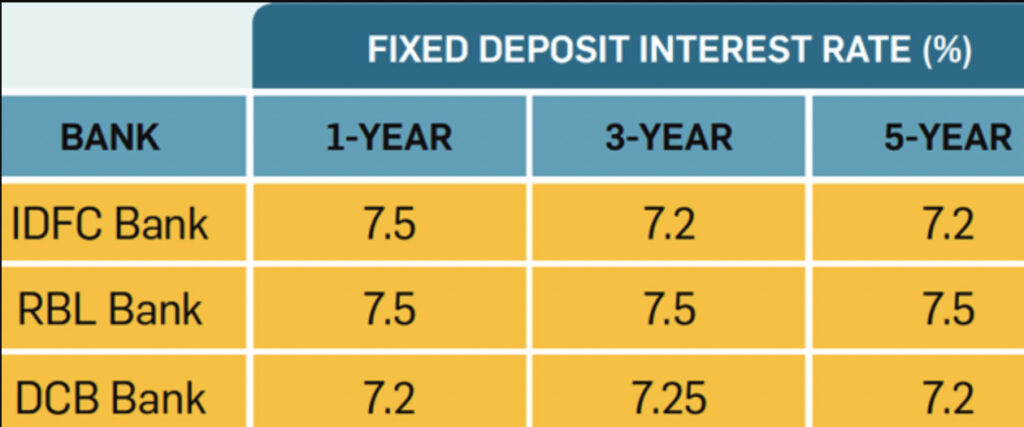
The fixed deposit or FD is one of the most prevalent financial vehicles offered by the majority of banks to their clients. It is a recommended investment option since it is more secure than equity investments. And you even know the returns prior to making the investment. It is a risk-free investment if you wish to avoid risk. It can also help you achieve your long-term financial goals, such as purchasing a home, funding your children’s education, or saving for retirement.
How Much Amount of FD Interest is Tax-Free?
When your total income is less than the minimum taxable amount, there is no deduction for TDS. Some investors may have annual interest income in excess of Rs 40,000, but their Total Income (including interest income) is below the minimum exempt income threshold (Rs 2.5 lakh)
When the individual has no tax liability, the bank cannot deduct TDS. In such circumstances, however, the bank will not deduct TDS if you submit Forms 15G or 15H to claim interest income exempt from TDS.
The tax-saving FD schemes have a 5-year lock-in period, and deposits of up to Rs 1.5 lakh per fiscal year are eligible for a tax deduction under Section 80C of the Income Tax Act. The same deduction applies to National Savings Time Deposit Accounts (commonly known as Post Office Fixed Deposits) opened for a 5-year term. FD interest income is taxed under “Income from other sources” on the income tax return.
Section 80TTB of the Income Tax Act permits senior citizens to deduct up to Rs 50,000 in fixed deposit interest.
What is TDS Associated with FDs? How Much Will the TDS be?
When you receive certain payments, the payer must deduct tax before making the payment. This tax is referred to as TDS (Tax deducted at source), and it is paid to the Central Government.
You will get the credit net of any applicable taxes. You must then include the gross amount in your income when filing your tax return. In contrast, the TDS credit is deducted from the overall tax liability, or a TDS refund is paid if there is no tax liability.
Section 194A of the Income Tax Act stipulates that TDS is applicable to interest generated on fixed deposits. If interest income surpasses Rs 40,000 (or Rs 50,000 for senior citizens) during the financial year, 10% TDS is deducted. If PAN information is not provided, however, 20% of TDS is withheld from interest revenue. Due to the fact that FD interest income is added to an individual’s annual income when filing tax returns, depositors who have filed Form 15G/H but have taxable income must pay tax according to their tax brackets when filing ITR.
What is the Income Tax on Interests?
Fixed Deposit interest income is fully taxable. It will be included in your total income and taxed at the respective slab rates. It must be declared on your tax return under the heading “Income from Other Sources.”
If the amount of interest credited to your account exceeds Rs.40,000 and you are not a senior citizen, the bank will deduct tax at source prior to crediting your account. threshold limit for senior citizens is Rs 50,000
Remember, then, that the TDS is deducted at the time interest is credited, not when the FD matures. Therefore, if you have an FD for three years, the bank will withhold TDS at the end of each year.
How does FD Account turn into Tax-Saving Asset?
Fixed deposits (FDs) are a common method of investing for the future. A tax-saving FD account is a type of fixed deposit account offered by a bank in accordance with Section 80C of the Income Tax Act of 1961. During the five-year lock-in period for FD tax-saving plans, funds cannot be withdrawn. It enables you to earn a greater interest rate, which, although taxable, will allow you to save tax on your FD investment. You may invest up to Rs 1.5 lakh in a tax-deferred fixed deposit. Ensure you compare your options for the best tax-free FD interest rates.
The interest generated on FD falls under “Other Sources of Income.” In addition to the Section 80C income tax savings choices, you can also save TDS on your FD income. This is especially useful if you fall below the Income Tax bracket and wish to avoid filing tax returns just for tax refunds.
You must submit Form 15G to the bank where you applied for your FD and indicate that you have no taxable income. The bank will then not collect any TDS from your interest earnings. Seniors who desire to avoid TDS are required to submit Form 15H.
Why Choose an FD to Invest?
- An FD account is a safe location to keep your funds, as neither the principal nor the interest can be affected by market fluctuations.
- In times of emergency, people rely on investments that can quickly liquidate, and fixed deposits come in handy. However, secured loans against FDs (up to 90% of the amount) are available at cheaper interest rates.
- You receive the same interest payment throughout the duration of your investment, regardless of market movements. The interest amount is credited annually, monthly, or quarterly, depending on your preferences.
- Almost every bank provides senior citizens with a greater interest rate. This is quite appealing to retirees.
- You may invest in tax-saving fixed deposits for five years to qualify for the 80C tax deduction.
- You can request that the bank transfer the funds to a new FD account, where they would yield greater returns.
Invest in Bajaj Finance Fixed Deposit. Bajaj Finance offers FD interest rate of 7.95% per annum.
Comments are closed.